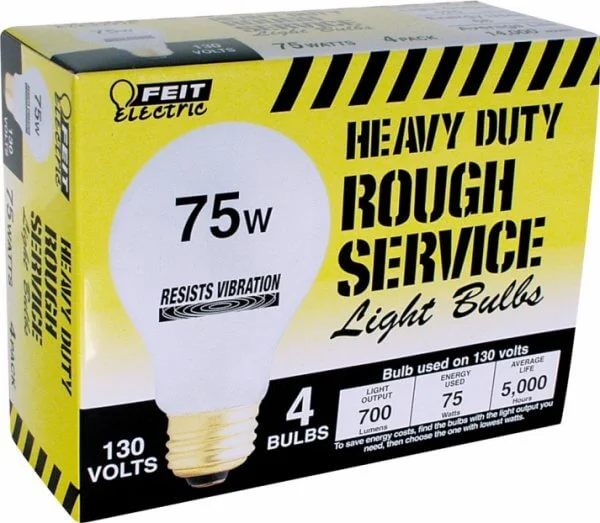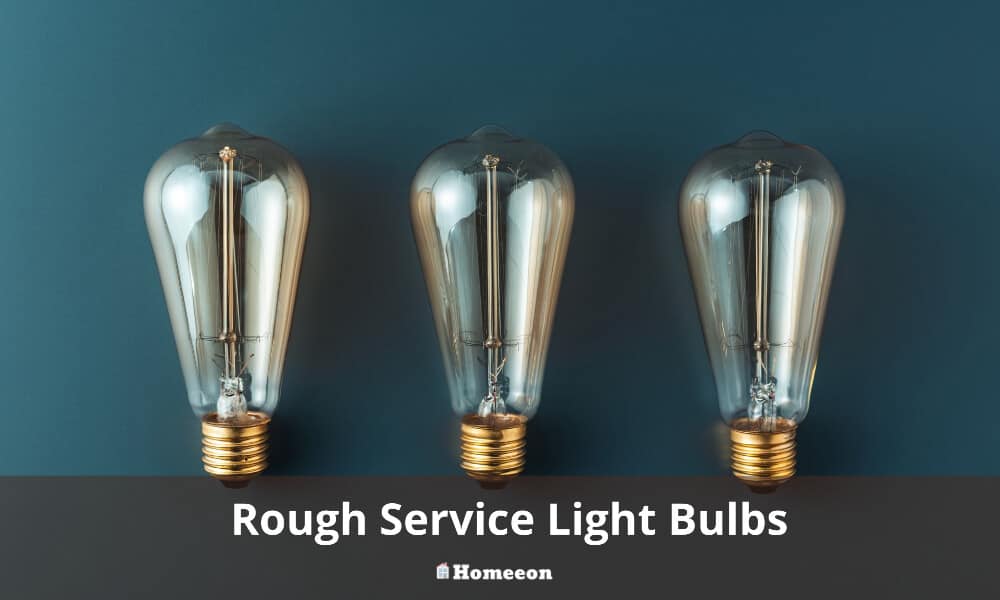Last Updated on August 15, 2023 By Emma W. Thomas
Rough service light bulbs are designed to withstand vibration, shock, and rough handling. They’re commonly used in industrial settings, garages, and workshops. These bulbs have reinforced filaments and thicker glass to ensure durability, making them last longer in challenging environments.
What are Rough Service Light Bulbs?
When it comes to lighting, finding the right bulbs for different environments or applications can be a challenge. Regular light bulbs may not withstand rough conditions and can easily break, resulting in costly replacements. That’s where rough service light bulbs come to the rescue. Designed to withstand more demanding conditions, these durable bulbs are built to last longer and provide reliable illumination. Let’s dive into the features, benefits, and common uses of rough service light bulbs.
Features of Rough Service Light Bulbs
- Extra Durability: Rough service light bulbs are constructed with reinforced filaments and more robust materials, making them resistant to vibrations, shocks, and impacts. This added durability prevents the filament from breaking easily, increasing the lifespan of the bulb.
- Thicker Glass: These bulbs feature thicker glass shells that provide additional protection against rough handling, preventing accidents or damage during installation or transportation.
- Special Coating: Some rough service light bulbs have a silicone-based coating that adds an extra layer of protection against moisture, dust, and chemicals, allowing them to be used in a wider range of environments.
Benefits of Rough Service Light Bulbs
- Longer Lifespan: Due to their sturdier construction, rough service light bulbs typically have a longer lifespan compared to regular bulbs. This not only reduces the frequency of bulb replacements but also saves money in the long run.
- Increased Safety: The durability of these bulbs makes them suitable for high-impact or heavy-duty applications, ensuring that they will not shatter easily. This helps prevent potential injuries or accidents due to broken glass.
- Versatility: Rough service light bulbs can be used in diverse settings where standard bulbs wouldn’t be able to withstand the conditions. These include workshops, garages, construction sites, outdoor lighting fixtures, and areas prone to vibrations.
Common Uses of Rough Service Light Bulbs
| Industries | Residential | Commercial |
|---|---|---|
| Manufacturing | Basements | Warehouses |
| Construction | Garages | Factories |
| Automotive | Outdoor Security | Workshops |
| Mining | Barns | Retail Stores |
| Marine | Sports Facilities |
In industries such as manufacturing, construction, automotive, mining, and marine, rough service light bulbs are essential due to the demanding environments they operate in. In residential settings, these bulbs effectively illuminate basements, garages, and outdoor security areas. Similarly, commercial spaces like warehouses, factories, workshops, retail stores, and sports facilities benefit from the robustness and longevity of these specialized bulbs.
Where to Use Vibrations Light Bulbs

You can use rough service light bulbs in any area where vibrations, shocks, or bumps are a major concern. These areas include lamps near machinery, garage door openers, closed doors that slam frequently, or areas where lamps frequently fail due to rough usage.
Main Types of Light Bulbs
There are four major types of light bulbs: CFL (compact fluorescent), incandescent, light-emitting diode (LED), and halogen.
- CFL (Compact fluorescent)
Compact fluorescent is an energy-efficient light bulb that can emit various colors depending on the model you select. The bulbs normally take some time to become warm and get brighter, but they are ideal for illuminating large spaces such as kitchens, basements, and great rooms.
CFL bulbs are more durable than incandescent lights and less expensive compared to LED lights. You will need to handle the bulbs carefully since they contain mercury. The lamps are also recyclable once they burn out.
2. Incandescent
Incandescent light bulbs are the most popularly used type of lamp and also the least expensive. They emit a warm light, and you can use them with dimmers. The bulbs last up to one year – longer than halogen bulbs but not as long as LED or CFL light bulbs.
Unlike other types of light bulbs, incandescent bulbs are not very energy-efficient.
3. LED ( Light-Emitting Diode)
LEDs are among the most energy-efficient type of light bulbs that contains no mercury, does not give off any heat, and emits a bright light. They are great for task lighting since they give directional light.
Some LEDs come with built-in fixtures and are therefore known as integrated LEDs. These bulbs can last up to 50,000 hours and are perfect for hard-to-reach areas.
4. Halogen
Halogen light bulbs emit a white light that arouses high-noon daylight. These lamps are ideal for pendant lights, under-cabinet, and recessed lighting since they are dimmable and energy-efficient.
Halogen lamps have the shortest lifespan among the four types, but they warm up fast and need to be kept away from fire-hazard materials. It is advisable to use gloves when changing hot halogen bulbs since they can explode when they contact with oil from your hands.
Can You Use LED Bulbs For Rough Service?
LEDs are the most efficient substitute for rough service bulbs. They had the undesired color of light and higher costs but have since improved. These light bulbs produce a glow like their rough service counterparts without compromising their lighting effect.
An ordinary A-shaped Led bulb costs as little as $1, and it is as inconspicuous as an incandescent lamp. A household LED bulb includes an integrated driver that manages the power supplied to it. The driver takes incoming voltage and steps it down to a lower voltage of about 12 or 24-volt power supply for the diodes.
How to Choose a Light Bulb
When choosing a light bulb, it is necessary to look for an energy-sufficient one, which creates the ideal lighting for your home. LEDs are primarily today’s bulbs as they fit ordinary sockets and are more energy-efficient.
LED light bulbs have fewer watts than incandescent bulbs, but they give out the same amount of light but use less energy. These bulbs can last up to 20 years and have no mercury. Here’s what to look for when selecting light bulbs:
- Lighting effect
The lighting you choose for a room will affect its mood and atmosphere. Combining the right bulbs and light fixtures will help to illuminate your home and create both functional and flattering outcomes.
2. Watts and Lumens
Watts represents the amount of energy your light bulb uses while lumens are light that a bulb emits. A bulb with more lumens is brighter while the one with fewer is dimmer. Lower watts mean less electric bill. LEDs and CFLs have lower wattage, but they give out the same light output as incandescent bulbs.
3. Color of Light
Light color or appearance is measured on the Kelvin scale. Lower Kelvin values mean more yellow light while higher numbers give bluer or whiter light. The standard color of incandescent light bulbs is soft white (yellowish), and their temperature ranges from 2700K to 3000K. This color is suitable for living rooms, bedrooms, and dens, or for highlighting dark woods.
For kitchens, workspaces, and bathrooms, warm white color (between yellowish and white), with a temperature range of 3000K to 4000K, is ideal.
If your kitchens and bathrooms have white or chrome fixtures, you can choose bright white (between white and blue), with temperatures ranging from 4000K to 5000K. Daylight (blue) is perfect for reading, and the values range from 5000K to 6500K.
Which Bulbs Give The Most Natural Light

Halogen bulbs are a type of incandescent bulbs that emit light close to natural daylight and are also known as white light. Colors look sharper under halogen light and can be dimmed. Although the bulbs are more energy-efficient than incandescent ones, they burn at a higher temperature and are more expensive.
Final Word
Rough service light bulbs are like incandescent bulbs but they have stronger filaments and can endure more stresses. You can use LEDs as an alternative to Vibration’s light bulb since they are more energy-efficient.
References:
https://blog.lightingsupply.com/blog/missing-your-incandescents-try-rough-service-bulbs
https://blog.1000bulbs.com/home/why-you-dont-need-a-rough-service-light-bulb
Emma is a graduate of Domestic Science or Family and Consumer Sciences (Home Economics) from the University of Wisconsin. She has 7 years of experience Working with the strategic section of BestBuy and now writing full-time for Homeeon.
From Managing the Home, Interiors, Cleaning, and Exteriors to Gardening and everything about Making A Home Liveable – is her passion and this Homeeon is the result of this.
Emma loves decorating her home with the best stuff found online. She cares about quality over anything and writes reviews about them here in Homeeon. Get in touch with her over Pinterest.
Keep reading her blogs.

